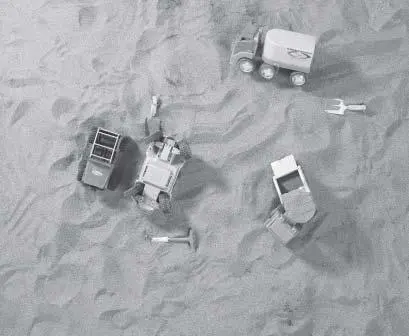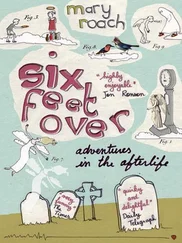Air Force historian Rudy Purificato is at work on a history of Wright-Patterson Air Force Base, the other hotbed of aerospace medicine research in the sixties. I sent him a note. “There could very well have been actual plans to send a chimp to the moon,” he replied. He added that most of the primate research was still classified, and in that case Fineg and Britz (and Purificato) couldn’t talk about what they knew. So who would have told the AP reporter? He had probably, Purificato said, benefited from a “slip-up” by someone he interviewed.
Holloman Air Force Base is a ten-minute drive from the New Mexico Museum of Space History. Perhaps the base archives could provide some answers. The curator here at the New Mexico museum, George House, gave me a phone number to try. The staff played hot potato with my call until someone could locate the Person in Charge of Lying to the Press. The PCLP said that the room that houses the base archives is locked. And that only the curator would have a key. And that Holloman currently has no curator. Evidently the new curator’s first task would be to find a way to open the archives. Now I was sure of it: the chimp-to-the-moon files were locked up in there along with the Enos in-flight sex tapes and pictures of Colonel Stapp in a tutu. Paranoia is a way of life here in Alamogordo, home of the first atomic bomb test and not far from Roswell and Area 51, the secretive Air Force experimental aircraft proving ground/UFO hub. House said that emails containing the word primate , including some from me, mysteriously disappear en route to his computer. But House didn’t think it had anything to do with secret chimp moon missions. He said it had to do with a lawsuit filed by People for the Ethical Treatment of Animals. The suit isn’t against the Air Force per se, but rather the facility they’d contracted to take over the care—“care” being a rather gross overstatement—of the chimpanzee colony in the 1970s, when the Air Force no longer had use for them. Oh.
I went back out to the missile garden and paged through my photocopies again. I noticed something I’d overlooked. One of the articles said that before being taken out of the capsule, the chimp Glenda “had to re-enter through the jarring forces of earth’s atmosphere.” That meant Glenda’s simulated mission was round-trip, not one-way.
I’m guessing that Glenda was a simulated Gemini astronaut. (The Gemini space program, 1965 to 1966, was the precursor to the Apollo program’s lunar missions.) From 1964 to early 1966, “Chimp College” primates were called on to provide answers to questions like, What will happen to an astronaut if his pressure suit tears while he’s outside the capsule? “Previously,” said the AP reporter who covered a series of chimpanzee-crewed EVA simulations designed to answer that question, “scientists believed direct exposure to space vacuum would result in death, with the blood boiling and the lack of atmospheric pressure possibly leading to the body expanding and even bursting.” [52] Contrary to popular lore, an astronaut’s blood does not boil if his spacesuit tears or his craft depressurizes. And though he would swell, he would not burst. The body functions as a sort of pressure suit for the blood, keeping dissolved gases in their liquid state. Only body fluids directly exposed to a vacuum actually boil. (As happened to a 1965 NASA test subject in a leaky spacesuit in an altitude chamber. The last thing he recalled before losing consciousness was the sensation of his saliva bubbling on his tongue.) Also, current EVA suits are designed to compensate for tears or leaks by blasting in air at far greater pressure. Bottom line: Provided he has an oxygen supply, an astronaut in a spacecraft depressurization has about two minutes to figure out what’s wrong and set it right. Beyond that he’s in trouble. This is known from experiments in vacuum chambers that would, if you knew the details, make your blood boil.
Yet another reason Holloman can’t get their archives door open.
That the prospect of a chimpanzee-piloted lunar mission was taken seriously enough to be printed as news demonstrates how political the Apollo space program had been. The goal? Pure and simple: Land something before they do. Science on the first lunar surface missions was something of an afterthought: Pick up some rocks while you’re there, okay? The first geologist wouldn’t set foot on the moon until Apollo 17, six missions later.
The Cold War has ended, and the goals of space exploration are ostensibly grounded in science. There are those who argue that the science is more effectively—or cost-effectively, at least—carried out by robotic landers. And that the main reason to employ humans in space exploration and planetary science is to maintain the public’s interest and support. As the saying goes, “No bucks without Buck Rogers.”
Others disagree. “If your goal is to answer very specific questions like, How hard are the rocks on the surface of Mars? a robot is perfect. If your questions are bigger, like, What is the history of Mars? well, that’s a hell of a lot of robots,” says Ralph Harvey, a planetary geologist who has helped plan research expeditions on the moon. “But it could be only one or two human beings. Because human beings have this amazing tool called intuition, where they’ve built up a catalogue of experiences and they can draw on it instantaneously and spend one minute looking at a scene—whether it’s on Mars or at a crime scene—and know what happened here.”
For the past twenty-three years, Harvey has overseen the Antarctic Search for Meteorites, so he knows a great deal about doing geology under extremely harsh conditions. When we spoke, he had just returned from NASA’s Goddard Space Flight Center, where he was helping plan a lunar traverse scheduled to take place sometime around 2025. [53] Or not at all, if the 2010 NASA budget passes as is.
Why does it take fifteen years to plan an outing on the moon? You’ll see.
9. NEXT GAS: 200,000 MILES
Planning a Moon Expedition Is Tough, but Not as Tough as Planning a Simulated One

Once upon a time, astronauts tooled around the moon in an open two-seat electric buggy. It was the sort of thing one might see on a golf course or at one of those big Miami delis whose elderly patrons appreciate a lift to and from the parking lot. It gave lunar exploration in the seventies a relaxed, retirement-community feel. That’s gone now. NASA’s new rover prototypes more resemble a futuristic camper van. The entire cab is pressurized, which is good, because that means the astronauts can take off their bulky, uncomfortable white bubble-head EVA suits. The NASA shorthand for a pressurized interior is “a shirtsleeve environment,” which makes me picture astronauts in polo shirts and no pants. If NASA ever builds an outpost on the moon, [54] Up until Obama’s first NASA budget appeared, in February 2010, the moon base was slated to be built sometime in the 2020s. That program (Constellation) has been cut, and now we’re headed to a near-Earth asteroid and on to Mars. Then again, Congress has yet to approve the budget plan, so it’s hard to know for sure, at the time of this writing, just where we’ll end up hauling our rovers next.
astronauts will be undertaking rover traverses of unprecedented length and complexity. Teams of explorers will head out in two vehicles that rendezvous daily, finally returning to the base after two weeks on the roll. The new rovers sleep two and are equipped with a food warmer, a toilet with “privacy curtain,” and cup holders (two).
Читать дальше













